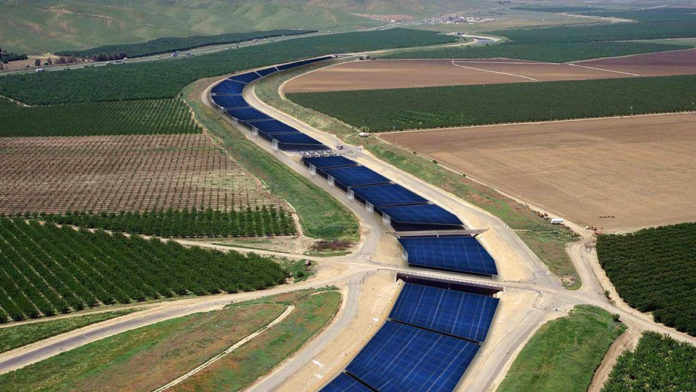Installing solar panels over California’s 4000 miles (6,350 km) of canals could generate less expensive, renewable energy, save water, fight climate change. New research shows that ‘solar canals’ could reduce evaporation and save upwards of 63 billion gallons of water annually while providing approximately 13 gigawatts of renewable power for the state.
The water savings would be comparable to the amount needed to irrigate some 50,000 acres of farmland or meet the residential water needs of over 2 million people. And the electricity generated would be equivalent to about one-sixth of the state’s current installed capacity or roughly half the projected new capacity needed by 2030 to meet the state’s decarbonization goals.
The new study, conducted by researchers from the University of California, Merced, and UC Santa Cruz, presents an analysis that quantifies the economic feasibility of building a solar canal system in the state by utilizing one of the world’s largest water systems, which supplies over 27 million citizens with vital water resources.
“We were surprised by the significant evaporation savings, which we project to be as much as 82%,” said Dr. Brandi McKuin, report lead author. “That amount of water can make a significant difference in water-short regions.” Because the solar panels shade the canals from direct sunlight, McKuin added, they can not only mitigate evaporation but also reduce the growth of aquatic weeds and reduce maintenance costs for operators. The evaporation that does occur, however, has the added benefit of cooling the solar panels above the waterway, thereby increasing their efficiency in converting sunlight to electricity.
The UC Solar AquaGrid study comes at a time when there is a growing urgency for shifting from fossil fuels to renewable energy. California is calling for 50% of California’s electricity to come from renewable sources by 2030 and all gas-powered vehicles to be phased out by 2035.
This study is a “modeling exercise” to show the potential of this idea; however, McKuin hopes this analysis will inspire utilities, as well as state and federal agencies, to test it out on the real waterways.
“What is most compelling about this study is when you tally up the multiple benefits,” comments the report co-author Roger Bales. “Solar over canals represents the sort of shift in thinking that California and the world need as we transition our economy and infrastructure to a fossil-free, sustainable future.” The analysis shows that adding solar coverings above canals that run across ‘already disturbed land’ means developers can avoid protracted environmental permitting and right-of-way issues so systems can be deployed more quickly and cost-effectively.
The concept of “solar canals” has been gaining momentum around the world as climate change increases the risk of drought in many regions. A “canal-top” solar power plant has already been successfully built in Gujarat, India, where solar panels covering a stretch of 750 m of a canal cost over $18 million to build in 2015. In other locations, floating solar panels have been installed on reservoirs and lakes around the world in places such as Japan and Indonesia.
